Python第三流行的Web框架
在2020年的Python开发者调查结果中,有这样一段话:“FastAPI在此次调查迭代中首次被引为选项,表现为Python第三流行的Web框架。”
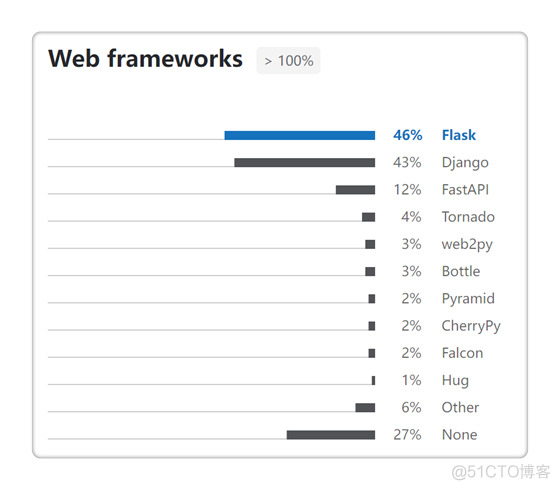
FastAPI创立于2018年12月,不到2年就成为仅次于Flask和Django的第三流行的Web框架。而又经过了一年发展来到2022年,虽然2021年Python开发者调查结果还没有出来,但是从GitHub的star来看,Flask 58.7k,Django 63.6k,FastAPI 44.2k,这个差距缩得越来越小。
FastAPI特性
这里就不做机器翻译了,大家看下原文:
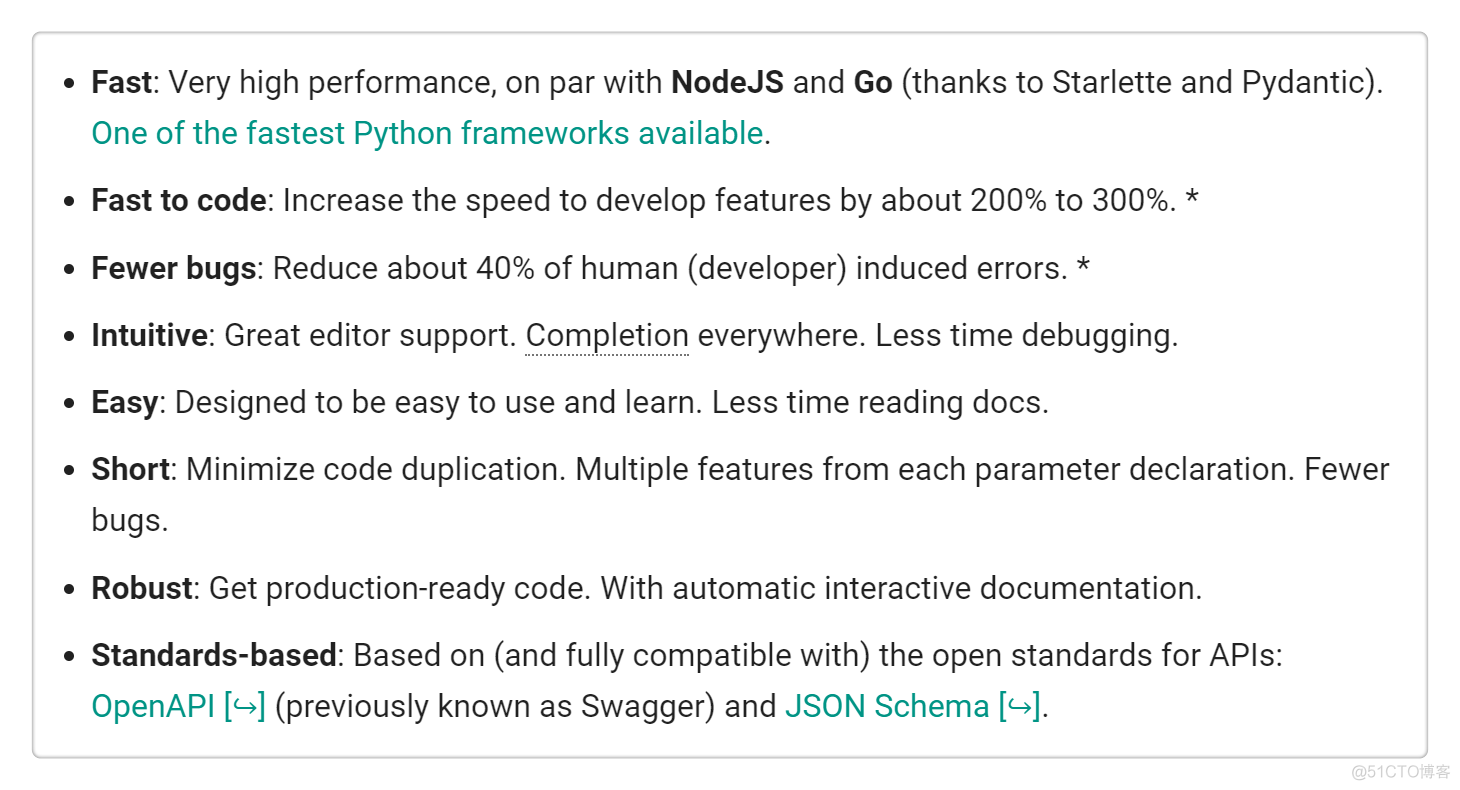
我说下我选择FastAPI的理由:首先就是HttpRunner集成了FastAPI,有大佬背书,相信这个框架足以优秀。其次是注解,用多了SpringBoot以后,越来越喜欢注解,层次清晰。对于前后端分离项目来说,Flask虽然非常精简却又自带了Jinja模板引擎,Django虽然是百宝箱却又显得太重,而FastAPI介于两者之间,就是一个纯粹的后端应用。并且FastAPI是基于Starlette框架的,集成了实用功能比如类型检查、OpenAPI(Swagger)等等,这跟我基于pytest框架做tep测试工具的理念很相似。
安装
对Python版本要求是3.6+。
先安装FastAPI:
pip install fastapi
再安装ASGI服务器,比如Uvicorn:
pip install "uvicorn[standard]"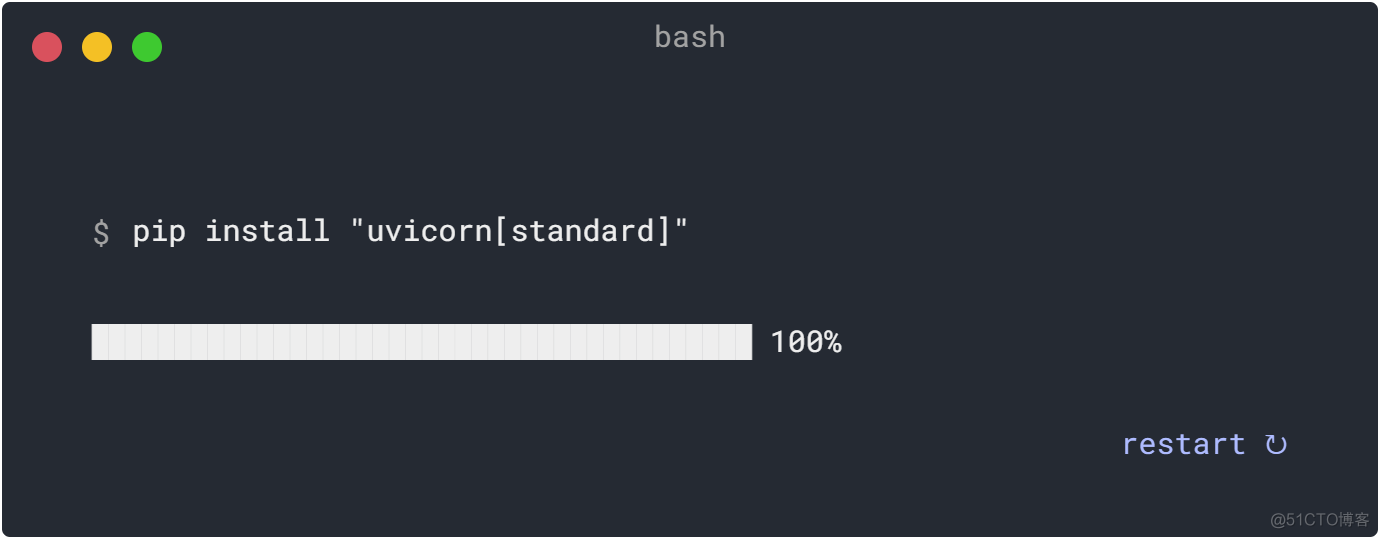
也可以同时安装fastapi和uvicorn:
pip install "fastapi[all]"运行
写个main.py文件:
from typing import Optionalfrom fastapi import FastAPI
app = FastAPI()
@app.get("/")
def read_root():
return {"Hello": "World"}
@app.get("/items/{item_id}")
def read_item(item_id: int, q: Optional[str] = None):
return {"item_id": item_id, "q": q}
在命令行输入启动应用:
uvicorn main:app --reloadmain是Python模块名。
app是app = FastAPI()。
--reload在代码变化时自动重启服务器。
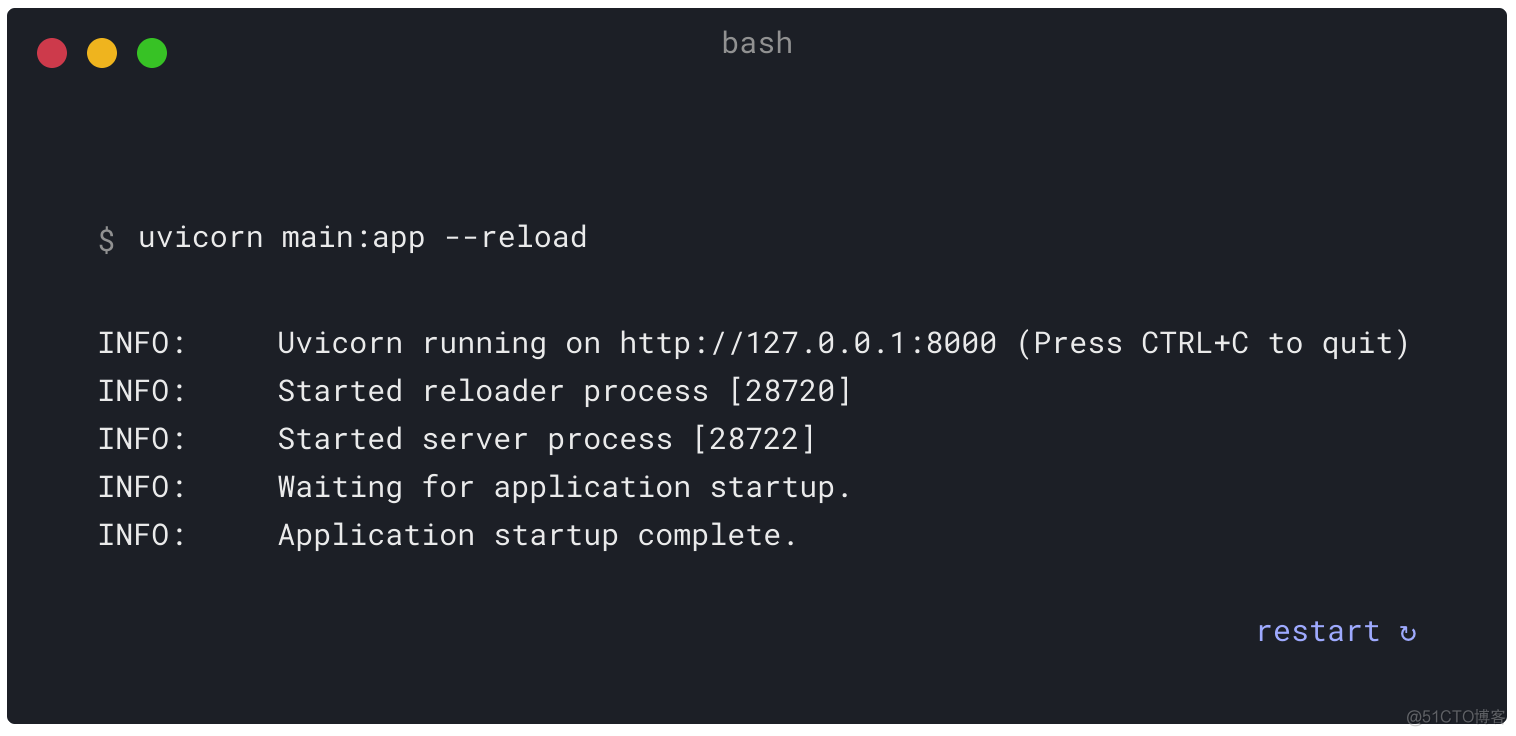
打开浏览器访问:
http://127.0.0.1:8000/items/5?q=somequery
就能看到JSON响应:
{"item_id": 5, "q": "somequery"}访问:
http://127.0.0.1:8000/docs
就能看到Swagger接口文档:
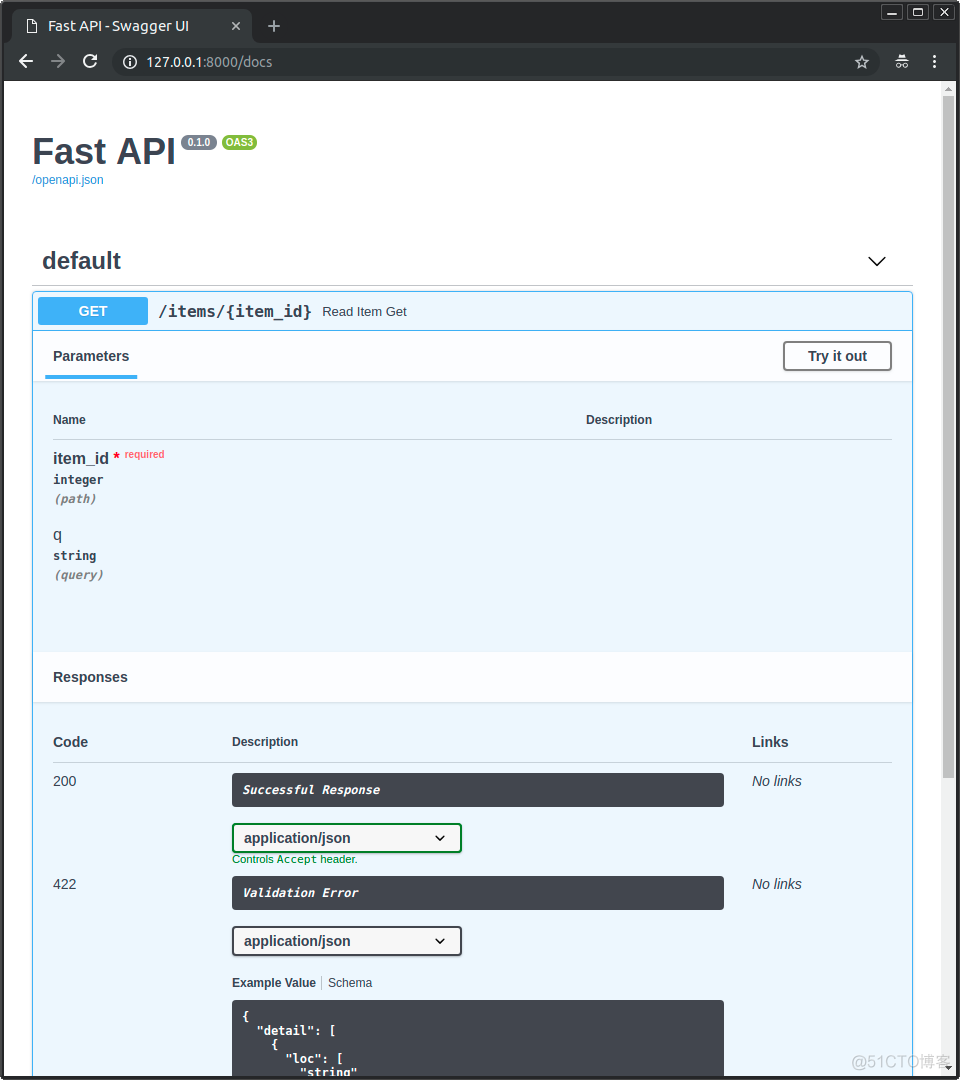
pydantic
pydantic是一个数据验证的库,FastAPI使用它来做模型校验。比如:
from typing import Optionalfrom fastapi import FastAPI
from pydantic import BaseModel
app = FastAPI()
class Item(BaseModel):
name: str
price: float
is_offer: Optional[bool] = None
@app.get("/")
def read_root():
return {"Hello": "World"}
@app.get("/items/{item_id}")
def read_item(item_id: int, q: Optional[str] = None):
return {"item_id": item_id, "q": q}
@app.put("/items/{item_id}")
def update_item(item_id: int, item: Item):
return {"item_name": item.name, "item_id": item_id}
Item是个入参模型,它的name必须str类型,price必须float类型,is_offer是可选的,可以为bool类型或不传。
PUT http://127.0.0.1:8000/items/6{
"name": "dongfanger",
"price": 2.3,
"is_offer": true
}
{
"item_name": "dongfanger",
"item_id": 6
}
路径参数
把路径参数传递给函数:
from fastapi import FastAPIapp = FastAPI()
@app.get("/items/{item_id}")
async def read_item(item_id):
return {"item_id": item_id}
也可以指定Python类型:
from fastapi import FastAPIapp = FastAPI()
@app.get("/items/{item_id}")
async def read_item(item_id: int):
return {"item_id": item_id}
效果是访问 http://127.0.0.1:8000/items/foo 会返回{"item_id":"foo"}。
指定了Python类型后,FastAPI会强制检查,比如传str会报错:
http://127.0.0.1:8000/items/foo
{"detail": [
{
"loc": [
"path",
"item_id"
],
"msg": "value is not a valid integer",
"type": "type_error.integer"
}
]
}
传float也会报错:
http://127.0.0.1:8000/items/4.2
匹配先后顺序
代码定义的先后顺序会决定匹配结果,比如正常来说,下面的/users/me会返回{"user_id": "the current user"}:
from fastapi import FastAPIapp = FastAPI()
@app.get("/users/me")
async def read_user_me():
return {"user_id": "the current user"}
@app.get("/users/{user_id}")
async def read_user(user_id: str):
return {"user_id": user_id}
假如这2个path定义顺序反过来,那么/users/me就会匹配到/users/{user_id}而返回{"user_id": me}了。
枚举路径
借助于Enun类,可以实现枚举路径:
from enum import Enumfrom fastapi import FastAPI
class ModelName(str, Enum):
alexnet = "alexnet"
resnet = "resnet"
lenet = "lenet"
app = FastAPI()
@app.get("/models/{model_name}")
async def get_model(model_name: ModelName):
if model_name == ModelName.alexnet:
return {"model_name": model_name, "message": "Deep Learning FTW!"}
if model_name.value == "lenet":
return {"model_name": model_name, "message": "LeCNN all the images"}
return {"model_name": model_name, "message": "Have some residuals"}
效果:
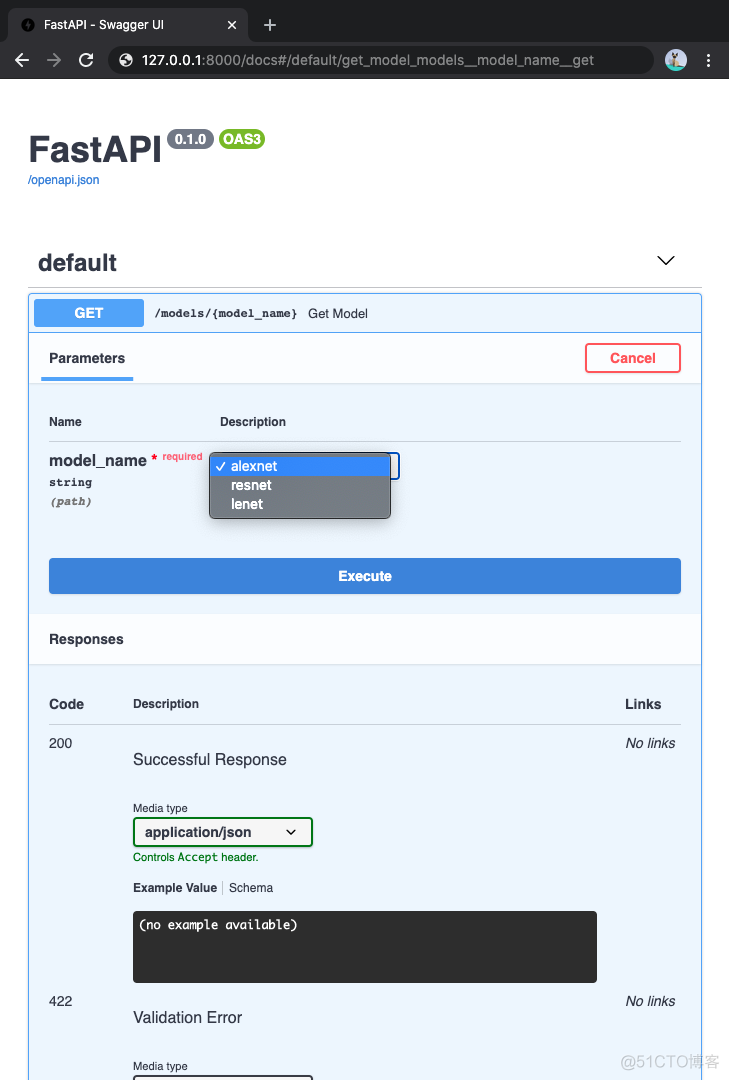
path匹配
FastAPI提供了一个path类型,可以用来对文件路径进行格式匹配:
from fastapi import FastAPIapp = FastAPI()
@app.get("/files/{file_path:path}")
async def read_file(file_path: str):
return {"file_path": file_path}
查询参数
查询参数是跟在路径参数后面,用?分隔用&连接的参数,比如http://127.0.0.1:8000/items/?skip=0&limit=10。
实现:
from fastapi import FastAPIapp = FastAPI()
fake_items_db = [{"item_name": "Foo"}, {"item_name": "Bar"}, {"item_name": "Baz"}]
@app.get("/items/")
async def read_item(skip: int = 0, limit: int = 10):
return fake_items_db[skip : skip + limit]
参数是可选的并且设置了默认值:limit: int = 10
参数是可选的,无默认值:limit: Optional[int] = None
注意:是否可选是由None来决定的,而Optional只是为编译器提供支持,跟FastAPI没有关系。
参数是必填的:limit: int
请求体
FastAPI的请求体借助于pydantic来实现:
from typing import Optionalfrom fastapi import FastAPI
from pydantic import BaseModel
class Item(BaseModel):
name: str
description: Optional[str] = None
price: float
tax: Optional[float] = None
app = FastAPI()
@app.post("/items/")
async def create_item(item: Item):
return item
继承于BaseModel来自定义Model,FastAPI会自动转换为JSON。
Pydantic PyCharm Plugin插件提高编码体验:
- auto-completion
- type checks
- refactoring
- searching
- inspections
路径参数+查询参数+请求体
总结一下,在函数参数中,url path中定义的叫做路径参数,没有定义的叫做查询参数,类型是pydantic model的叫做请求体,FastAPI会根据这套规则来自动识别:
from typing import Optionalfrom fastapi import FastAPI
from pydantic import BaseModel
class Item(BaseModel):
name: str
description: Optional[str] = None
price: float
tax: Optional[float] = None
app = FastAPI()
@app.put("/items/{item_id}")
async def create_item(item_id: int, item: Item, q: Optional[str] = None):
result = {"item_id": item_id, **item.dict()}
if q:
result.update({"q": q})
return result
查询参数字符串校验
FastAPI提供了Query来支持对入参的字符串校验,比如最小长度和最大长度:
from typing import Optionalfrom fastapi import FastAPI, Query
app = FastAPI()
@app.get("/items/")
async def read_items(
q: Optional[str] = Query(None, min_length=3, max_length=50, regex="^fixedquery$")
):
results = {"items": [{"item_id": "Foo"}, {"item_id": "Bar"}]}
if q:
results.update({"q": q})
return results
甚至其中也能包含正则表达式:regex="^fixedquery$"。
用Query时指定默认值:
from fastapi import FastAPI, Queryapp = FastAPI()
@app.get("/items/")
async def read_items(q: str = Query("fixedquery", min_length=3)):
results = {"items": [{"item_id": "Foo"}, {"item_id": "Bar"}]}
if q:
results.update({"q": q})
return results
用Query时必填:
from fastapi import FastAPI, Queryapp = FastAPI()
@app.get("/items/")
async def read_items(q: str = Query(..., min_length=3)):
results = {"items": [{"item_id": "Foo"}, {"item_id": "Bar"}]}
if q:
results.update({"q": q})
return results
查询参数传list
from typing import List, Optionalfrom fastapi import FastAPI, Query
app = FastAPI()
@app.get("/items/")
async def read_items(q: Optional[List[str]] = Query(None)):
query_items = {"q": q}
return query_items
指定默认值:
from typing import Listfrom fastapi import FastAPI, Query
app = FastAPI()
@app.get("/items/")
async def read_items(q: List[str] = Query(["foo", "bar"])):
query_items = {"q": q}
return query_items
url就像这样:http://localhost:8000/items/?q=foo&q=bar
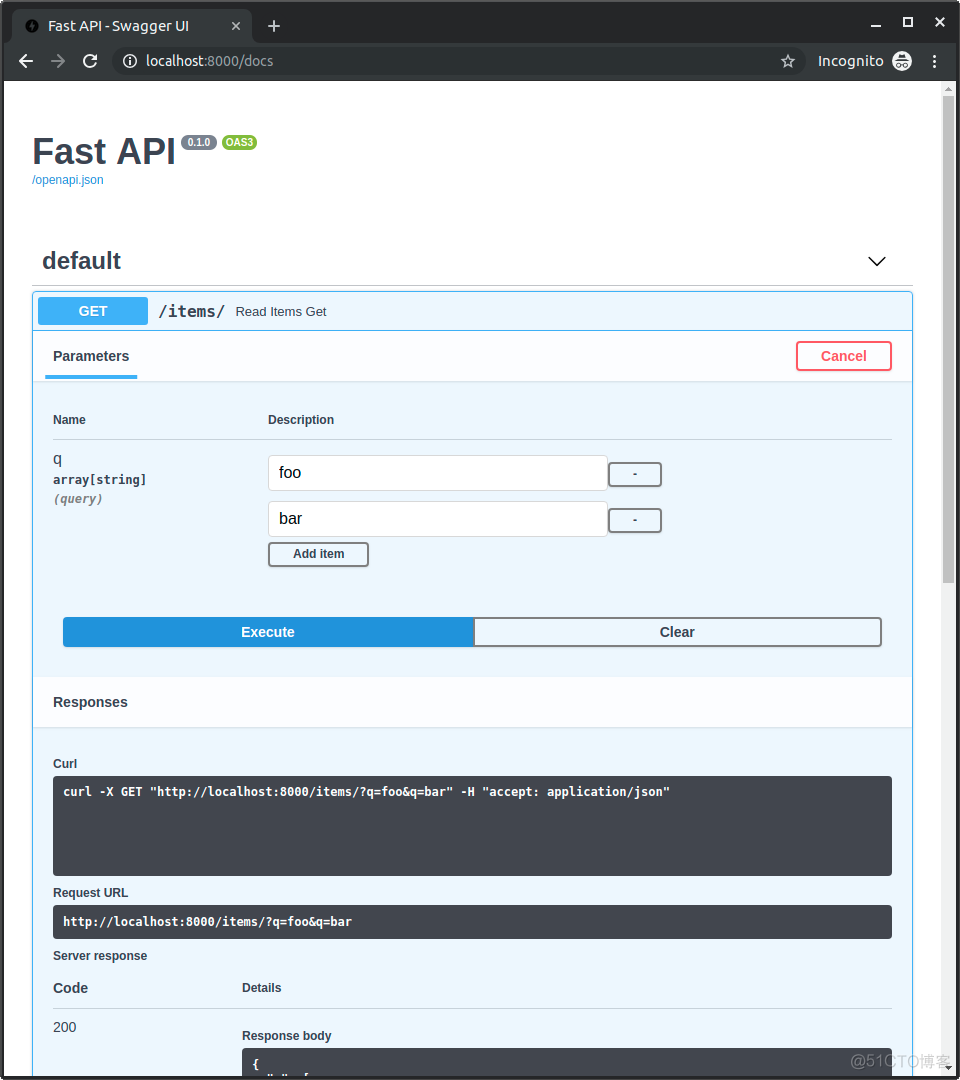
指定别名,比如http://127.0.0.1:8000/items/?item-query=foobaritems中的item-query不是Python变量命名,那么可以设置别名:
from typing import Optionalfrom fastapi import FastAPI, Query
app = FastAPI()
@app.get("/items/")
async def read_items(q: Optional[str] = Query(None, alias="item-query")):
results = {"items": [{"item_id": "Foo"}, {"item_id": "Bar"}]}
if q:
results.update({"q": q})
return results
路径参数数字校验
查询参数用Query做字符串(String)校验,路径参数用Path做数字(Numeric)校验:
from fastapi import FastAPI, Pathapp = FastAPI()
@app.get("/items/{item_id}")
async def read_items(
*,
item_id: int = Path(..., title="The ID of the item to get", gt=0, le=1000),
q: str,
):
results = {"item_id": item_id}
if q:
results.update({"q": q})
return results
路径参数永远都是必填的,因为它是url一部分。...表示必填,就算设置为None也没有用,仍然是必填。
ge表示大于等于,greater equal。
le表示小于等于,less equal。
gt表示大于,greater than。
lt表示小于,less than。
请求体-多参数
一、如果请求体嵌套了多个JSON:
{"item": {
"name": "Foo",
"description": "The pretender",
"price": 42.0,
"tax": 3.2
},
"user": {
"username": "dave",
"full_name": "Dave Grohl"
}
}
那么就需要在FastAPI中定义多参数:
from typing import Optionalfrom fastapi import FastAPI
from pydantic import BaseModel
app = FastAPI()
class Item(BaseModel):
name: str
description: Optional[str] = None
price: float
tax: Optional[float] = None
class User(BaseModel):
username: str
full_name: Optional[str] = None
@app.put("/items/{item_id}")
async def update_item(item_id: int, item: Item, user: User):
results = {"item_id": item_id, "item": item, "user": user}
return results
这里定义了2个Model:Item和User。
二、而如果多个参数中有个参数只是单个值,比如这里的importance:
{"item": {
"name": "Foo",
"description": "The pretender",
"price": 42.0,
"tax": 3.2
},
"user": {
"username": "dave",
"full_name": "Dave Grohl"
},
"importance": 5
}
那么定义成变量并赋值= Body()即可:
@app.put("/items/{item_id}")async def update_item(item_id: int, item: Item, user: User, importance: int = Body()):
results = {"item_id": item_id, "item": item, "user": user, "importance": importance}
return results
三、在只有一个Item的时候,FastAPI默认会接收这样的body:
{"name": "Foo",
"description": "The pretender",
"price": 42.0,
"tax": 3.2
}
假如想把item也放到JSON中:
{"item": {
"name": "Foo",
"description": "The pretender",
"price": 42.0,
"tax": 3.2
}
}
那么可以使用Body(embed=True)):
from typing import Unionfrom fastapi import Body, FastAPI
from pydantic import BaseModel
app = FastAPI()
class Item(BaseModel):
name: str
description: Union[str, None] = None
price: float
tax: Union[float, None] = None
@app.put("/items/{item_id}")
async def update_item(item_id: int, item: Item = Body(embed=True)):
results = {"item_id": item_id, "item": item}
return results
请求体-字段
Pydantic提供了Field来给body中的字段添加额外校验:
from typing import Unionfrom fastapi import Body, FastAPI
from pydantic import BaseModel, Field
app = FastAPI()
class Item(BaseModel):
name: str
description: Union[str, None] = Field(
default=None, title="The description of the item", max_length=300
)
price: float = Field(gt=0, description="The price must be greater than zero")
tax: Union[float, None] = None
@app.put("/items/{item_id}")
async def update_item(item_id: int, item: Item = Body(embed=True)):
results = {"item_id": item_id, "item": item}
return results
跟FastAPI提供的Query、Path、Body作用类似。
请求体-嵌套模型
传List:
from typing import List, Unionfrom fastapi import FastAPI
from pydantic import BaseModel
app = FastAPI()
class Item(BaseModel):
name: str
description: Union[str, None] = None
price: float
tax: Union[float, None] = None
tags: List[str] = []
@app.put("/items/{item_id}")
async def update_item(item_id: int, item: Item):
results = {"item_id": item_id, "item": item}
return results
传Set,自动去重:
from typing import Set, Unionfrom fastapi import FastAPI
from pydantic import BaseModel
app = FastAPI()
class Item(BaseModel):
name: str
description: Union[str, None] = None
price: float
tax: Union[float, None] = None
tags: Set[str] = set()
@app.put("/items/{item_id}")
async def update_item(item_id: int, item: Item):
results = {"item_id": item_id, "item": item}
return results
传Model:
from typing import Set, Unionfrom fastapi import FastAPI
from pydantic import BaseModel
app = FastAPI()
class Image(BaseModel):
url: str
name: str
class Item(BaseModel):
name: str
description: Union[str, None] = None
price: float
tax: Union[float, None] = None
tags: Set[str] = set()
image: Union[Image, None] = None
@app.put("/items/{item_id}")
async def update_item(item_id: int, item: Item):
results = {"item_id": item_id, "item": item}
return results
入参会像这样:
{"name": "Foo",
"description": "The pretender",
"price": 42.0,
"tax": 3.2,
"tags": ["rock", "metal", "bar"],
"image": {
"url": "http://example.com/baz.jpg",
"name": "The Foo live"
}
}
对于url,pydantic提供了HttpUrl来做校验:
class Image(BaseModel): url: HttpUrl name: str
传Model的List:
from typing import List, Set, Unionfrom fastapi import FastAPI
from pydantic import BaseModel, HttpUrl
app = FastAPI()
class Image(BaseModel):
url: HttpUrl
name: str
class Item(BaseModel):
name: str
description: Union[str, None] = None
price: float
tax: Union[float, None] = None
tags: Set[str] = set()
images: Union[List[Image], None] = None
@app.put("/items/{item_id}")
async def update_item(item_id: int, item: Item):
results = {"item_id": item_id, "item": item}
return results
入参像这样:
{"name": "Foo",
"description": "The pretender",
"price": 42.0,
"tax": 3.2,
"tags": [
"rock",
"metal",
"bar"
],
"images": [
{
"url": "http://example.com/baz.jpg",
"name": "The Foo live"
},
{
"url": "http://example.com/dave.jpg",
"name": "The Baz"
}
]
}
添加示例请求
通过Config和schema_extra添加示例请求:
from typing import Unionfrom fastapi import FastAPI
from pydantic import BaseModel
app = FastAPI()
class Item(BaseModel):
name: str
description: Union[str, None] = None
price: float
tax: Union[float, None] = None
class Config:
schema_extra = {
"example": {
"name": "Foo",
"description": "A very nice Item",
"price": 35.4,
"tax": 3.2,
}
}
@app.put("/items/{item_id}")
async def update_item(item_id: int, item: Item):
results = {"item_id": item_id, "item": item}
return results
在使用以下任一时,都可以添加example:
- Path()
- Query()
- Header()
- Cookie()
- Body()
- Form()
- File()
比如:
from typing import Unionfrom fastapi import FastAPI
from pydantic import BaseModel, Field
app = FastAPI()
class Item(BaseModel):
name: str = Field(example="Foo")
description: Union[str, None] = Field(default=None, example="A very nice Item")
price: float = Field(example=35.4)
tax: Union[float, None] = Field(default=None, example=3.2)
@app.put("/items/{item_id}")
async def update_item(item_id: int, item: Item):
results = {"item_id": item_id, "item": item}
return resultsfrom typing import Union
from fastapi import Body, FastAPI
from pydantic import BaseModel
app = FastAPI()
class Item(BaseModel):
name: str
description: Union[str, None] = None
price: float
tax: Union[float, None] = None
@app.put("/items/{item_id}")
async def update_item(
item_id: int,
item: Item = Body(
example={
"name": "Foo",
"description": "A very nice Item",
"price": 35.4,
"tax": 3.2,
},
),
):
results = {"item_id": item_id, "item": item}
return resultsfrom typing import Union
from fastapi import Body, FastAPI
from pydantic import BaseModel
app = FastAPI()
class Item(BaseModel):
name: str
description: Union[str, None] = None
price: float
tax: Union[float, None] = None
@app.put("/items/{item_id}")
async def update_item(
*,
item_id: int,
item: Item = Body(
examples={
"normal": {
"summary": "A normal example",
"description": "A **normal** item works correctly.",
"value": {
"name": "Foo",
"description": "A very nice Item",
"price": 35.4,
"tax": 3.2,
},
},
"converted": {
"summary": "An example with converted data",
"description": "FastAPI can convert price `strings` to actual `numbers` automatically",
"value": {
"name": "Bar",
"price": "35.4",
},
},
"invalid": {
"summary": "Invalid data is rejected with an error",
"value": {
"name": "Baz",
"price": "thirty five point four",
},
},
},
),
):
results = {"item_id": item_id, "item": item}
return results
额外数据类型
FastAPI除了支持常见的数据类型:
- int
- float
- str
- bool
还支持额外的数据类型:
- UUID
- datetime.datetime
- datetime.date
- datetime.time
- datetime.timedelta
- frozenset
- bytes
- Decimal
示例:
from datetime import datetime, time, timedeltafrom typing import Union
from uuid import UUID
from fastapi import Body, FastAPI
app = FastAPI()
@app.put("/items/{item_id}")
async def read_items(
item_id: UUID,
start_datetime: Union[datetime, None] = Body(default=None),
end_datetime: Union[datetime, None] = Body(default=None),
repeat_at: Union[time, None] = Body(default=None),
process_after: Union[timedelta, None] = Body(default=None),
):
start_process = start_datetime + process_after
duration = end_datetime - start_process
return {
"item_id": item_id,
"start_datetime": start_datetime,
"end_datetime": end_datetime,
"repeat_at": repeat_at,
"process_after": process_after,
"start_process": start_process,
"duration": duration,
}
Cookie
from typing import Unionfrom fastapi import Cookie, FastAPI
app = FastAPI()
@app.get("/items/")
async def read_items(ads_id: Union[str, None] = Cookie(default=None)):
return {"ads_id": ads_id}
跟Query和 Path用法类似。
Header
from typing import Unionfrom fastapi import FastAPI, Header
app = FastAPI()
@app.get("/items/")
async def read_items(user_agent: Union[str, None] = Header(default=None)):
return {"User-Agent": user_agent}
多重header用List,比如:
from typing import Unionfrom fastapi import FastAPI, Header
app = FastAPI()
@app.get("/items/")
async def read_items(user_agent: Union[str, None] = Header(default=None)):
return {"User-Agent": user_agent}X-Token: foo
X-Token: bar{
"X-Token values": [
"bar",
"foo"
]
}
响应模型
通过response_model定义返回模型:
from typing import List, Unionfrom fastapi import FastAPI
from pydantic import BaseModel
app = FastAPI()
class Item(BaseModel):
name: str
description: Union[str, None] = None
price: float
tax: Union[float, None] = None
tags: List[str] = []
@app.post("/items/", response_model=Item)
async def create_item(item: Item):
return item
response_model的作用是对函数返回值进行过滤,比如:
from typing import Unionfrom fastapi import FastAPI
from pydantic import BaseModel, EmailStr
app = FastAPI()
class UserIn(BaseModel):
username: str
password: str
email: EmailStr
full_name: Union[str, None] = None
class UserOut(BaseModel):
username: str
email: EmailStr
full_name: Union[str, None] = None
@app.post("/user/", response_model=UserOut)
async def create_user(user: UserIn):
return user
函数返回值是UserIn模型的对象user,而response_model的值为UserOut(UserOut相比于UserIn来说,没有password),那么FastAPI的响应,就是用UserOut对UserIn进行了过滤,返回的是没有password的UserOut。
响应模型可以返回默认值:
from typing import List, Unionfrom fastapi import FastAPI
from pydantic import BaseModel
app = FastAPI()
class Item(BaseModel):
name: str
description: Union[str, None] = None
price: float
tax: float = 10.5
tags: List[str] = []
items = {
"foo": {"name": "Foo", "price": 50.2},
"bar": {"name": "Bar", "description": "The bartenders", "price": 62, "tax": 20.2},
"baz": {"name": "Baz", "description": None, "price": 50.2, "tax": 10.5, "tags": []},
}
@app.get("/items/{item_id}", response_model=Item, response_model_exclude_unset=True)
async def read_item(item_id: str):
return items[item_id]
response_model_exclude_unset=True不返回未显式设置的字段,response_model_exclude_defaults不返回带默认值的字段,response_model_exclude_none不返回None的字段。
附加模型
在上面的示例中,UserIn是入参,UserOut是出参,不包含password,但是在实际情况中,还需要第三个模型UserInDB,在存入数据库时,把password进行加密。
代码实现如下:
from typing import Unionfrom fastapi import FastAPI
from pydantic import BaseModel, EmailStr
app = FastAPI()
class UserIn(BaseModel):
username: str
password: str
email: EmailStr
full_name: Union[str, None] = None
class UserOut(BaseModel):
username: str
email: EmailStr
full_name: Union[str, None] = None
class UserInDB(BaseModel):
username: str
hashed_password: str
email: EmailStr
full_name: Union[str, None] = None
def fake_password_hasher(raw_password: str):
return "supersecret" + raw_password
def fake_save_user(user_in: UserIn):
hashed_password = fake_password_hasher(user_in.password)
user_in_db = UserInDB(**user_in.dict(), hashed_password=hashed_password)
print("User saved! ..not really")
return user_in_db
@app.post("/user/", response_model=UserOut)
async def create_user(user_in: UserIn):
user_saved = fake_save_user(user_in)
return user_saved
重点是user_in_db = UserInDB(**user_in.dict(), hashed_password=hashed_password)里面的**user_in.dict()。
user_in是UserIn类的Pydantic模型,它有个dict()方法能返回字典。**是拆包,把字典拆成key value的形式,上面这行代码等价于:
UserInDB(username="john",
password="secret",
email="john.doe@example.com",
full_name=None,
hashed_password=hashed_password
)
也相当于:
UserInDB(username = user_dict["username"],
password = user_dict["password"],
email = user_dict["email"],
full_name = user_dict["full_name"],
hashed_password = hashed_password,
)
FastAPI的一大设计原则是尽量减少重复代码,所以对于UserIn、UserOut、UserInDB可以把里面的相同字段抽象为一个UserBase,其他Model继承即可:
from typing import Unionfrom fastapi import FastAPI
from pydantic import BaseModel, EmailStr
app = FastAPI()
class UserBase(BaseModel):
username: str
email: EmailStr
full_name: Union[str, None] = None
class UserIn(UserBase):
password: str
class UserOut(UserBase):
pass
class UserInDB(UserBase):
hashed_password: str
def fake_password_hasher(raw_password: str):
return "supersecret" + raw_password
def fake_save_user(user_in: UserIn):
hashed_password = fake_password_hasher(user_in.password)
user_in_db = UserInDB(**user_in.dict(), hashed_password=hashed_password)
print("User saved! ..not really")
return user_in_db
@app.post("/user/", response_model=UserOut)
async def create_user(user_in: UserIn):
user_saved = fake_save_user(user_in)
return user_saved
response_model除了定义一个Model以外,也能定义多个附加模型。
比如Union:
from typing import Unionfrom fastapi import FastAPI
from pydantic import BaseModel
app = FastAPI()
class BaseItem(BaseModel):
description: str
type: str
class CarItem(BaseItem):
type = "car"
class PlaneItem(BaseItem):
type = "plane"
size: int
items = {
"item1": {"description": "All my friends drive a low rider", "type": "car"},
"item2": {
"description": "Music is my aeroplane, it's my aeroplane",
"type": "plane",
"size": 5,
},
}
@app.get("/items/{item_id}", response_model=Union[PlaneItem, CarItem])
async def read_item(item_id: str):
return items[item_id]
比如List:
from typing import Listfrom fastapi import FastAPI
from pydantic import BaseModel
app = FastAPI()
class Item(BaseModel):
name: str
description: str
items = [
{"name": "Foo", "description": "There comes my hero"},
{"name": "Red", "description": "It's my aeroplane"},
]
@app.get("/items/", response_model=List[Item])
async def read_items():
return items
比如Dict:
from typing import Dictfrom fastapi import FastAPI
app = FastAPI()
@app.get("/keyword-weights/", response_model=Dict[str, float])
async def read_keyword_weights():
return {"foo": 2.3, "bar": 3.4}
参考资料:
https://fastapi.tiangolo.com/
所有文章公众号【测试开发刚哥】首发!
版权申明:本文为博主原创文章,转载请保留原文链接及作者。
